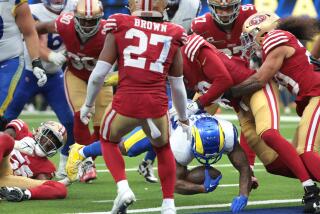Getting a Rush From Lives of Pains, Gains : Williams Has Name, Numbers to Remember
- Share via
Talk to 100 college recruiters and you may get 100 reasons why they landed or lost a prospect.
It may be the location of the college.
The coach.
Teammates.
The scholarship program.
But talk to Mike Shanahan, now the Raider coach, formerly an assistant at Florida, and you’ll hear a reason you undoubtedly have never heard before: a plane crash.
Shanahan had been trying to corral a player from nearby Palatka High School in the small Florida town of the same name. For Shanahan, it had become a labor of love.
“I probably spent more time recruiting John L. Williams than any other player I’ve ever recruited,” Shanahan said. “He was the top back in the state and, at that time, there were a lot of good backs in Florida.
“I got a chance to get very close to his family. I got a chance to get very close to him. He did a great job when he was in college in relationship to his academics. He handles himself with a lot of class and, as everybody knows, he’s a fine football player. I just think the world of him. He was like a son to me.”
And Shanahan played the role of the proud father, attending every Palatka football game during Williams’ final two seasons there.
Yet despite all that, Williams wasn’t sure which college he wanted to attend. He liked Shanahan, and he liked the idea of playing about 50 miles from home, and yet there were other temptations.
Namely Oklahoma. The Sooners wanted to fly Williams in for a visit.
He was all set to go, too, until the day before the trip. Then, in Washington, D.C., on Jan. 13, 1982, a plane crashed into the Potomac River in bad weather, killing 78.
Williams decided he had two choices: Go on a plane or go with Shanahan.
“That plane crash changed my mind,” Williams said. “I wanted no more flying. When all those people were killed, there was no way I was going to get up in the air.”
Instead, Williams landed at Florida.
It turned out to be a great decision, whatever the reasoning. He wound up third in Florida history in rushing yards with 2,409 and third in all-purpose yardage with 3,444. He was the No. 1 all-time receiver among the school’s running backs with 92 catches for 863 yards and 7 touchdowns. And he was the first player at Florida to total more than 2,000 yards rushing and 800 yards receiving.
He had seven 100-yard rushing games and one in which he caught 12 passes for 103 yards.
Keep in mind that he accomplished this while sharing backfield duty, at one time or another, with Neal Anderson, Lorenzo Hampton and James Jones, all of whom went on to become first-round draft picks in the National Football League.
Williams also became a first-round pick in 1986, going to Seattle, where he has formed a new partnership with Curt Warner in what may someday be a 2,000-yard backfield.
Warner already has his 1,000 this season, and Williams might have had it, were it not for a shoulder injury that hampered him for 4 games.
As it is, Williams is racking up numbers that rival those he collected in college.
He has gained 818 yards rushing and averaged 4.7 per carry, already making him the second-best rusher in club history behind Warner.
Williams has gained more than 100 yards 3 times this season. Twice in the last 3 weeks (against the Denver Broncos last Sunday and the Raiders 2 weeks earlier), Williams and Warner each rushed for more than 100 yards. Seahawk runners had never done that before.
Impressed? Then there’s Williams’ receiving, the area in which he’s really doing a number on the Seahawk record book.
Williams has 51 catches for 471 yards to lead all Seattle receivers. The yardage is a Seahawk single-season mark for a running back. The reception total is 3 short of the Seahawk record for a back, set by Dan Doornink in 1979.
And if Williams should emerge from Sunday’s regular-season finale as the team’s top receiver, it would mark the first time in the Seahawks’ 13 years of existence that anyone other than Steve Largent had led the club in pass catching. Largent would need 14 catches just to tie Williams.
“He can do it all,” Shanahan said of Williams. “He can block. He’s so deceptive when he runs. It doesn’t look like he’s going that fast, but he’s just a little bit faster than the guy chasing him. You can’t bring him down. And he’s just an excellent receiver. He could catch anything. He could come up with the big catch, the big run. In college, he had a run against Mississippi State where he breaks about 6 tackles and goes for about 75 yards, one of the best runs I’ve ever seen. A fullback very seldom will go that distance.”
Shanahan just hopes that he doesn’t see anything similar Sunday. Three thousand miles and 6 years removed from Palatka, Shanahan will still be watching Williams perform, this time at the Coliseum. And this time, it could be Shanahan’s future on the line as the Seahawks and Raiders play for the AFC West title and a berth in the playoffs.
When these teams met at the Kingdome 3 weeks ago, the running of Williams and Warner was a key to Seattle’s 35-27 victory.
“I don’t think our ability to run comes down to any one secret,” Warner said. “It’s a combination of a lot of things, like throwing the ball well and keeping it for a considerable amount of time. Anytime you can control the football, you can do some things.
“John L. has taken some pressure off me. When you have a combination like that back there, it makes it better for all of us.”
And awfully tough on the opposition. After all, Williams is a man who makes practically no demands. Call on him to block. Call on him to run. Call on him to catch.
Just don’t call him John.
Or Williams.
Or anything other than John L. That is his only demand.
Williams likes to tell a story about a friend who kept coming to his house in Florida.
“Three times he came to the door and asked for John,” Williams said. “And each time, my mother said, ‘John doesn’t live here.’
“Finally, he got the idea. The next time, he asked for John L.”
Why is Williams so insistent on this point?
“Because that’s my name.”
And what does the L stand for?
“It doesn’t stand for anything. It just sits there.”
Which is something anyone who has ever see him on a football field would never say about John L. Williams.
More to Read
Go beyond the scoreboard
Get the latest on L.A.'s teams in the daily Sports Report newsletter.
You may occasionally receive promotional content from the Los Angeles Times.










